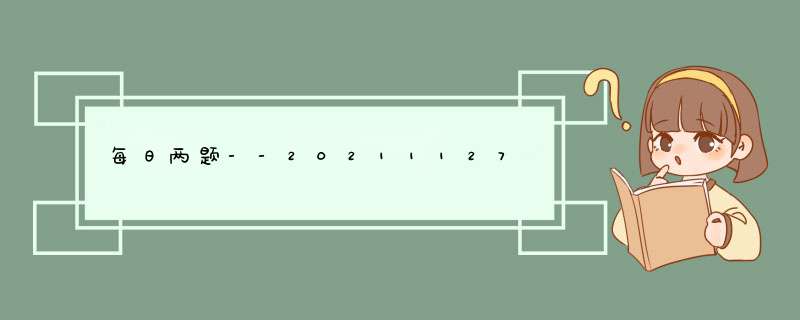
描述
给你一个正整数数组 arr ,请你计算所有可能的奇数长度子数组的和。
子数组 定义为原数组中的一个连续子序列。
请你返回 arr 中 所有奇数长度子数组的和 。
思路
- 尝试寻找数组中每一个数相加的次数,及系数
- 对于第1个元素的系数a[1] = n / 2 + n % 2,n为数组长度;
- 对于第2个元素的系数a[2] = a[1] - 1 + (n- 1) / 2 + (n -1) % 2;
- 不难得出,对于第i个元素的系数a[i] = a[i] = a[i - 1] - (i / 2 + i % 2) + (n- i) / 2 + (n- i) % 2;
- 将对应元素值与其系数相乘再相加即可得出结果
题解
int sumOddLengthSubarrays(int* arr, int arrSize)
{
int a[100] = {0};
int sum = 0;
a[0] = arrSize / 2 + arrSize % 2;
for(int i = 1; i < arrSize; i++)
{
a[i] = a[i - 1] - (i / 2 + i % 2) + (arrSize - i) / 2 + (arrSize - i) % 2;
}
for(int i = 0; i < arrSize; i++)
{
sum += arr[i] * a[i];
}
return sum;
}
面试题 17.13. 恢复空格
描述
哦,不!你不小心把一个长篇文章中的空格、标点都删掉了,并且大写也弄成了小写。像句子"I reset the computer. It still didn’t boot!“已经变成了"iresetthecomputeritstilldidntboot”。在处理标点符号和大小写之前,你得先把它断成词语。当然了,你有一本厚厚的词典dictionary,不过,有些词没在词典里。假设文章用sentence表示,设计一个算法,把文章断开,要求未识别的字符最少,返回未识别的字符数。
示例:
输入:
dictionary = [“looked”,“just”,“like”,“her”,“brother”]
sentence = “jesslookedjustliketimherbrother”
输出: 7
解释: 断句后为"jess looked just like tim her brother",共7个未识别字符。
提示:
0 <= len(sentence) <= 1000
dictionary中总字符数不超过 150000。
你可以认为dictionary和sentence中只包含小写字母。
思路
首先想到的是动态规划,因为要返回的最少未匹配的字符数,所以对于串sentence ,可以先定义前i个字符串最少未匹配的字符数,再算出前i+1个字符串最少未匹配的字符数,只需要找出其中的关系即可
- 状态定义,dp[i]用来表示前i个字符串最少未匹配的字符数
- 状态转移,接下来表示dp[i + 1]
- 第i+1个字符串不管匹不匹配,先以不匹配处理,即dp[i + 1] = dp[i] + 1(后续如果匹配到了,但是匹配后未匹配字数更多了,则不如不匹配)
- 如果刚好有第idx~i的字符串与字典中匹配,则取dp[idx]和dp[i]的中的小值,更新dp[i + 1],即dp[i + 1] = math.min(dp[idx], dp[i + 1])
题解
还是老实用java写方便,09afd9sjoqjihbn
class Solution {
public int respace(String[] dictionary, String sentence) {
//整了个set,后面好处理字符串
Set dic = new HashSet<>(Arrays.asList(dictionary));
int n = sentence.length();
int[] dp = new int[n + 1];
for(int i = 1; i < n + 1; i++){
//先按未匹配处理加1;
dp[i] = dp[i - 1] + 1;
//如果匹配到了取小值
for(int idx = 0; idx < i; idx++){
if(dic.contains(sentence.substring(idx, i))){
dp[i] = Math.min(dp[i], dp[idx]);
}
}
}
return dp[n];
}
}
拓展
可以通过构造字典树来查询以第 i + 1 个字符为结尾的单词有哪些(构建字典树时将单词逆序插入即可),在进行匹配查找时可以减少时间复杂度,关于字典树,可以看字典树,用字典树优化解法如下
class Solution {
public int respace(String[] dictionary, String sentence) {
// 构建字典树
Trie trie = new Trie();
for (String word: dictionary) {
trie.insert(word);
}
// 状态转移,dp[i] 表示字符串的前 i 个字符的最少未匹配数
int n = sentence.length();
int[] dp = new int[n + 1];
for (int i = 1; i <= n; i++) {
dp[i] = dp[i - 1] + 1;
for (int idx: trie.search(sentence, i - 1)) {
dp[i] = Math.min(dp[i], dp[idx]);
}
}
return dp[n];
}
}
class Trie {
TrieNode root;
public Trie() {
root = new TrieNode();
}
// 将单词倒序插入字典树
public void insert(String word) {
TrieNode cur = root;
for (int i = word.length() - 1; i >= 0; i--) {
int c = word.charAt(i) - 'a';
if (cur.children[c] == null) {
cur.children[c] = new TrieNode();
}
cur = cur.children[c];
}
cur.isWord = true;
}
// 找到 sentence 中以 endPos 为结尾的单词,返回这些单词的开头下标。
public List search(String sentence, int endPos) {
List indices = new ArrayList<>();
TrieNode cur = root;
for (int i = endPos; i >= 0; i--) {
int c = sentence.charAt(i) - 'a';
if (cur.children[c] == null) {
break;
}
cur = cur.children[c];
if (cur.isWord) {
indices.add(i);
}
}
return indices;
}
}
class TrieNode {
boolean isWord;
TrieNode[] children = new TrieNode[26];
public TrieNode() {}
}
欢迎分享,转载请注明来源:内存溢出

 微信扫一扫
微信扫一扫
 支付宝扫一扫
支付宝扫一扫
评论列表(0条)